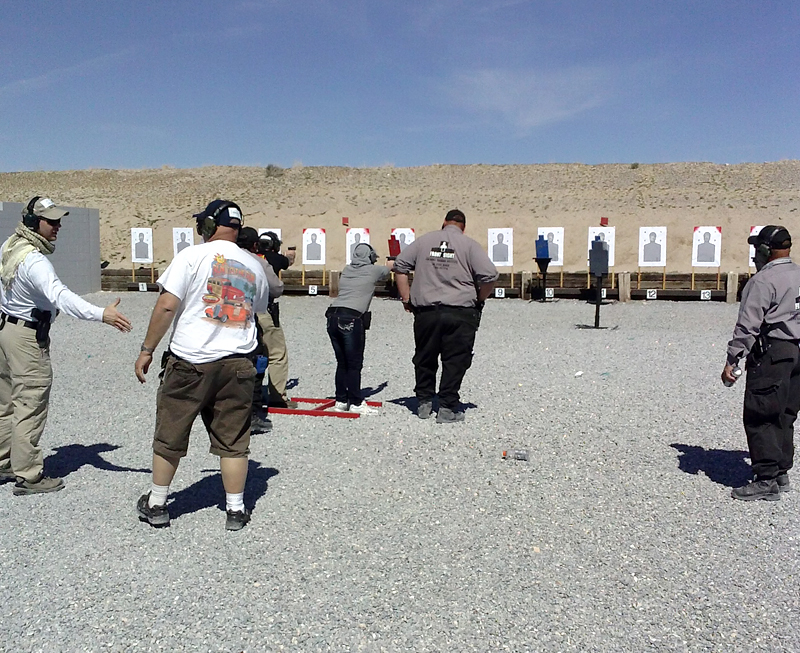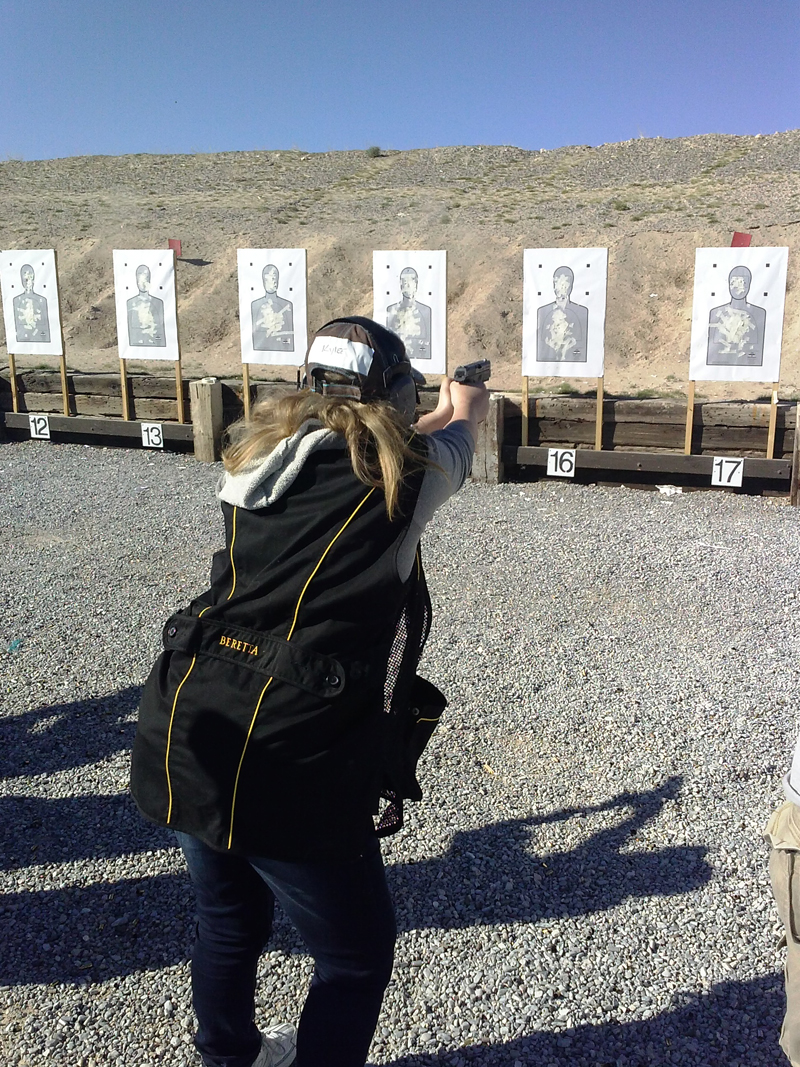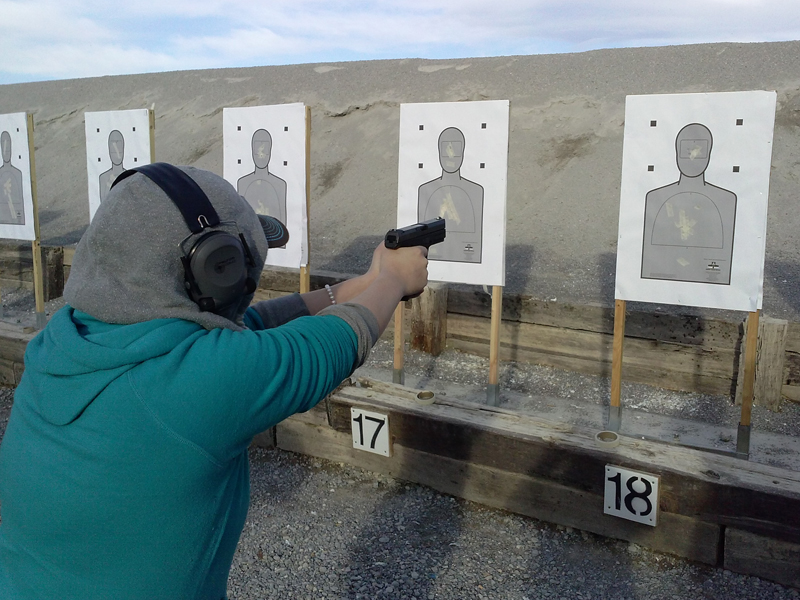4-Day Defensive Handgun
Front Sight Course Review
Tanner B.
-
4 Day Defensive Handgun
- Student: Tanner B.
- Occupation: N/A
- Weapon: Browning Hi Power 9mm with a Kholster IWB holster
- Rounds Fired: Approx. 550 Rounds of 9mm.
- Number Course Taken:1st time
- Student Rating: 9/10
- Course: Front Sight






General Comments
I purchased a 4 day course certificate during one of the promotional discount periods that Front Sight offers a few times a year for $89.00. Last I checked, the retail price of the course was somewhere around $2,000, but I find it hard to believe that anyone should or would pay full price with all of the deals they offer. Yes, they do flood your inbox with ads, but the $89 offer ($69 for the first few days) made it worth putting up with. I was a bit skeptical at first, but after doing some research and reading many great reviews I decided to pull (I mean, press - reset) the trigger. An annual $50 background check fee is mandatory and must be paid to Front Sight before attending a course.
There is a lot of negative press regarding the founder, Dr. Piazza, and his business dealings. This revolves around some bad real estate deals he made while opening Front Sight; he planned to build homes, people bought the lots, and they were never built due to cash flow issues. These people sued, won, and are being paid back. The claims about Scientology may or may not be true, but I heard no mention of this while at the facility and cannot speak to it. You will be asked to sit through 2 - 3 thirty minute video presentations describing Front Sight's goals and the courses they offer. These presentations are 100% optional and you are not required to sit through them. No hard sales tactics or time-share type "free course" pitches were given, just the videos and talk to the guy in the back if you are interested (several in my class were).
Front Sight is located about an hour from Las Vegas (where I live). On the first day I left that morning and arrived at about 6:15am for weapons inspection, ammo inspection, and check in. You must bring a properly functioning handgun in a holster that holds the weapon securely and covers the trigger guard. Ammo is given the "magnet test" to ensure that there is no steel core that would penetrate steel targets. Steel cased ammo (Tula, Brown Bear, Blazer, etc.) is fine as long as it will not attract a magnet. IWB and OWB holsters may both be used, though I was the only one in my class to use an IWB rig. Both revolvers and semi-automatics may be used, though semi-autos dominate the field. At least 2 (3 is preferred) magazines or speed loaders and pouches are needed. If you are with a group, make sure to say this during check in and you will be directed to a range number. Back inside you will listen to a few presentations on weapons handling and safety, a brief overview of what to expect, and sign a rather lengthy waiver. There is a pro shop on site which sells mags, holsters, belts, ammo, etc. However, expect to pay $50 for a Glock mag and $23.00 for a 50 round box of 9mm.
Front Sight has no food or lodging amenities, so I decided to order my lunches in advance from a place in Pahrump that delivers out there (info is on the Front Sight page). $12.95 a day gets you a huge freshly made sandwich (15 or so types available), a bag of chips, water, potato/macaroni salad, fresh baked cookies, a sliced apple, bag of peanuts, some candy, and a mint. The food impressed me every day and it is definitely worth it. I stayed at the Saddle West hotel in Pahrump which offers a discount for Front Sight students. I paid around $45 a night (week days) for a large, comfy bed and a free breakfast buffet each morning. (You have to sign a dry practice agreement with the hotel, which I found amusing.)
On your range you will meet approximately 30 of your classmates, as well as your instructors. I cannot speak for other ranges, but our instructors were INCREDIBLE teachers. Every single one of them was extremely polite, knowledgeable, and had a sense of humor. Before each new drill, you will watch a demonstration of your instructor completing it (with live ammo) with expert precision. Unlike many schools where they never fire a shot, these guys can all be put on the spot to complete each drill you do perfectly. Most had prior military/police experience and nearly all were considered "Combat Masters" within Front Sight's testing procedures; they made this clear with their performance. What made them stand out so much was their down to earth mentality: you won't have drill instructors yelling at you, but showing you calmly what you did wrong and how to improve. At first you are nervous when you hear gravel as they approach, but after a day or so you are appreciative to hear what could make your draw more time efficient. They were all great guys and had us laughing about as much as we were shooting.
The first day consists mostly of drilling the proper way to holster, unholster, dry practice, the 4 rules of safety, and shooting fundamentals (sight picture, sight alignment, and trigger control). We shot maybe 100 live rounds at Front Sight's own proprietary targets which supposedly represent the average of more than 1000 x-rays of everyday people from Dr. Piazza's chiropractor practice [Editor's Note: Dr. Piazza was a practicing chiropractor prior to starting Front Sight]. Two hit zones are designated on the target: the Thoracic Cavity (a half circle from the sternum to the esophagus, out to the nipples), and the Cranial-Ocular Cavity (a rectangle covering the eye brows down to the mustache and out to the ends of the eye lids). Each and every single threat is to be met with a "Controlled Pair" to the center of the Thoracic Cavity; two shots in this area historically have the greatest chance to take non-drugged opponent out of the fight while minimizing collateral damage.
Day 2 started with a video lecture on Front Sight's intentions and a live lecture on the moral and ethical issues surrounding the use of deadly force. Time on the range was spent with shooting from the holster, tactical reloads, emergency reloads, and type I & II malfunctions. We shot around 200 live rounds. Shooting is done in 2 "relays" with a buddy system. Your shooting partner is your coach when you are shooting, standing behind you to correct mistakes you made and ensure all safety rules are followed. Once each drill is completed and the range is cold, you go down range and tape your target for your buddy. We also introduced the concept of "Failure to Stop" in the event a controlled pair did not stop our attacker; this is a single well placed shot to the center of the cranial-ocular cavity.
Day 3 built upon previously developed skills, adding concealment into the mix. We shot around 150 rounds. I was the only person to use both an IWB (KHolster) and a sweat-shirt for concealment. Everyone else in the class chose to use a Serpa or Fobus style OWB holster and conceal with a vest, no doubt in part to our instructor mentioning that this was the fastest method if you wanted to "game" the skills test. Still, this is the way I carry every day, so it was more important for me to get better than anything else. We had a lecture about clearing buildings and how to overcome the "funnels of death" (doorways) before heading out to a range appropriately called Monsters, Inc. The range featured about 30 free standing door frames and doors with a dummy "red" plastic gun for each of us. An instructor showed us the proper way to sweep a door, shoot from corners, and clear a room. Directly after this we went to the "shoot house" where you will move through a simulated house with multiple armed targets to save a hostage. My instructor framed this as my daughter and I was surprised at how real this scenario felt. I won't give away the details in case they don't change things around, but you will be firing live ammo at photo-realistic paper targets indoors. It makes a HUGE difference to shoot at real people rather than grey silhouettes, especially when they are pointing guns at you. Also strange was shooting inside a "house". If all you have ever done is shot outside or indoor ranges, it really changes your mindset. I had chills as I executed a perfect "hostage rescue" headshot on my daughter's captor. Don't forget your tactical reloads during the lulls in the fight, and don't let your nerves get the best of you! I didn't experience tunnel vision, but you are noticeably "amped" both during and after the simulation. We had another lecture on what to do after a violent encounter (dealing with police, finding a lawyer, etc.) and it wasn't the same old "DON'T TALK" lecture; there is a lot more to it than that. We finished the day with dry practice, a marksmanship "ragged hole" challenge, and malfunction clearances including type III's. I happened to win the ragged hole drill and had my target cut out to take home. By this point all of my finger tips were raw, some were bleeding, and I was looking forward to a cold beer.
Day 4 took everything we did during the course and rolled it together. Drawing from concealment, controlled pairs to the center of the thoracic cavity, single well-placed headshots, tactical reloads, emergency reloads, type I, II, and III malfunctions, after-action drills, engaging multiple threats, prioritizing fire, threat assessment, and the fundamentals of marksmanship. Throughout the course time pressure was added to each drill and ramped up slowly by way of a shot timer. Halfway through the day we had a man-on-man skills competition which consisted of drawing from concealment and engaging three steel plate targets, the first of which is a hostage rescue shot on a 4" by 4" plate at 10 yards. The point of the competition was not to find the best shooter, but to see how stress affected us. Being that I was shooting 115gr 9mm target loads, I had to hit the top right corner in order to get the hostage-taker plate to flip. The mantra that slow is smooth and smooth is fast really presented itself here. Luckily, I actually went all the way through the competition (single elimination) and ended up winning! It was great fun and I would like to get into IDPA or some other type of similar competition.
Finally was the skills test which is comprised of all of the aforementioned skills under strict time and accuracy pressure. I believe the maximum is 125 points and a 70% or greater is required to "graduate" while a 90% is required to earn the title of "distinguished graduate". A miss on body is -3 points while a miss off body is -5. Being late on any drill is -3 points. Passing is TOUGH as there are at least 2 dozen individual drills; it's possible, though, although many people received a final score of less than zero and most (even many who had been there previously) did not graduate. Unfortunately, I missed Distinguished Graduate by only 2 just-barely-late reloads, as my mags do not drop free. However, I still graduated with the best score in the class from deep concealment; for that I am very proud.
The course DID NOT give me a big head however. In fact, I was incredibly humbled. Gun fighting is scary hard, fast, and brutal. There are no second chances and you have to make split second decisions under extreme stress. You never have enough time and you never have enough ammo. Also, handguns suck. Period. In my opinion, the first rule of a gun fight is to NOT BE IN A GUN FIGHT, the second is to have a gun, and the third is to bring a long gun if at all possible. Though I practice regularly, received previous instruction, drill with snap caps, and learn all I can, I was in no way prepared to be in a gun fight. I still don't feel like I am, and I will be returning to take FS's Advanced handgun course as well as Tactical shotgun.
Final take: If you carry concealed, wait for a good deal and absolutely go to Front Sight. If you do this for a living, get your department to pay for it and go next week. It will completely change your outlook on firearms and their use for the better. Many of the people in my course were current military and police and all of them commented that they had never received training as good as they received at Front Sight.
Recommended gear:
- Electronic ear protection – putting foam ears in and out is a pain
Editor's Note: Electronic "ears" are actually required by Front Sight
- Eye protection (if you wear glasses, make sure you get the type of protection that is designed to be worn over prescription glasses)
- -The weapon and holster you carry. Even if it's an LCP, if you carry that every day, USE IT. I do not believe that ankle or pocket holsters are allowed, but I could be wrong [Editor's Note: he's not wrong; they aren't allowed]. As for caliber, .380/.38 spl is the minimum for the course. The pro shop will rent you a Glock 19 or an XD with a Serpa holster for $100.
- Sturdy gun belt like the Wilderness or Uncle Mikes instructors belt
- 600 rounds of FMJ or TMJ ammo. JHP's can be used if you are made of money. You can pick up your brass [Editor's Note: However, Front Sight's official policy is that only factory new ammunition is allowed on their ranges – no reloads]. You must buy their crazy expensive ammo if you rent a gun.
- 3 magazines and 2 magazine pouches. More would make life easier.
- A LULA magazine re-loader. This was worth 3 times the price for saving my thumbs.
- Cargo pants or a fanny pack to store loose ammo/magazines
- Gloves which don't interfere with your shooting too much, but protect your fingers. They will be raw, I promise.
- Comfortable shoes and appropriate clothing.
Editor's Note: Due to the fact that Front Sight's facilities are in the middle of the desert, the temperature extremes are, well, extreme.
- A brimmed ball cap is required when shooting.
- A backup weapon and holster. One guy kaboomed his FNX .40 with a 9mm round.... D'oh!
- Hotel (you can camp, weather permitting), sport water bottle, pre-ordered lunch
- Snapcaps for safe type II and III malfunction clearance practice
I recommend a gun with drop free mags, but I was able to graduate using my old Hi Power with an IWB Kholster under a sweatshirt. Any gun will do, but speed is king if you want to DG the test.
Do you have any tips for first-time students of this course?
I recommend that students bring the following gear: cargo pants, gloves that don't interfere with your shooting too much but protect your fingers, a sturdy gun belt, and electronic ear protection.
Would you suggest this course to others?
Yes, I would suggest this course to others.
How did you get there?
I drove from Las Vegas, which is where I live.
How did you handle the lunch situation?
I got the preordered lunches at Front Sight.
What other courses do you plan on taking in the future?
4-Day Tactical Shotgun Course
4-Day Handgun Combat Master Prep